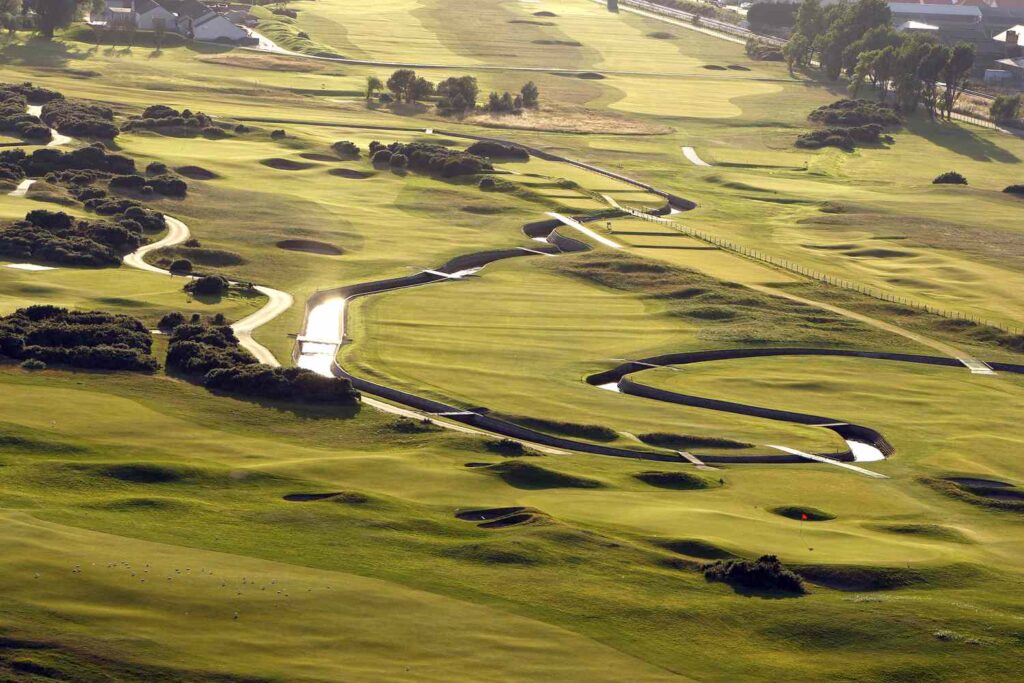
Are you a golf enthusiast wondering what all the buzz is about when people mention “links golf courses”? Whether this unique type of golf course has caught your ear or the idea of venturing onto its lush fairways actively intrigues you, fear not! In this blog post, we’ll explore and explain everything there is to know about links golf courses.
From their geographic origin to what sets them apart from conventional courses, you’ll get an insight into the exciting world of links – one that goes beyond photos of impossibly green rolling hills, rustic buildings & pot bunkers alongside fierce windswept fairways.
An Overview of Links Golf Courses
A links golf course essentially refers to the oldest style of golf course, first developed in Scotland. The word “links” is derived from the ancient English word “hlinc,” which means ‘rising ground’ or ‘ridge’. These courses were traditionally located on the coast, and the land itself was often used for golf because it was unsuitable for farming.
Therefore, the terrain at a link course is naturally undulating with rough and sandy soil. The landscape is dotted with dunes, and you won’t find many trees or water bodies, unlike other types of golf courses.
Instead, the challenges come from the thick, rough, rolling fairways, deep bunkers, and often strong winds due to the coastal location. The Old Course at St. Andrews and the Royal and Ancient Golf Club of St Andrews are famous examples of traditional links courses.
The History of Links Golf
The history of links golf is a fascinating journey that takes us back to the game’s roots in Scotland during the 15th century. As the sport of golf began to evolve, so did the courses, with links layouts being the earliest form of golf terrain. The term ‘links’ was used to describe the sandy soil that connected the sea to the farmland.
On these barren strips of land, golf began to take shape. The naturally undulating terrain and harsh coastal weather conditions helped shape a style of play that was greatly distinct from what we see today. Over time, these courses became known for their strategic design, challenging nature, and iconic pot bunkers.
The first known links course is The Old Course at St. Andrews, which is considered the ‘Home of Golf.’ It has been a template for many courses that followed. Today, links courses continue to be celebrated for their unique and enduring design, and playing a round of golf on a links course is considered a purist’s experience, taking players back to the origins of this beloved game.
Unique Characteristics of Links Courses
Links golf courses are distinguished by several unique characteristics that set them apart from other styles of golf courses:
- Undulating Terrain: One of the most notable features of links courses is their naturally uneven terrain. The fairways on these courses rarely follow a straight path, and the greens can be small and hard to hit, adding an extra challenge for the golfers.
- Coastal Location: These courses are typically located along the coastline, exposing them to strong winds that can drastically affect a golfer’s strategy and shot selection.
- Natural Hazards: Instead of artificial water hazards and trees, links courses utilize natural elements as obstacles. This includes tall, thick grass known as “rough” and large, deep sand bunkers called “pot bunkers.”
- Firm and Fast Conditions: The sandy soil of a links course drains quickly, which tends to make the ground very firm and the ball rolls farther. The course conditions can also change rapidly with the weather, offering a different experience with each round played.
- Minimal Water Hazards: Unlike many modern golf courses, links courses typically do not feature water hazards. This is due to their coastal location, where the terrain doesn’t lend itself to ponds or lakes.
- Strategic Course Design: The design of links courses often requires golfers to think carefully about their shots and plan strategically due to the placement of bunkers, the direction of the wind, and the potential for unpredictable bounces on uneven terrain.
Benefits of Playing on Links Golf Courses
Playing on Links golf courses offers a variety of benefits that are as unique as the courses themselves. As a golfer, you’ll be challenged in new and exciting ways due to the unpredictable terrain and changing conditions. This can greatly enhance your skills, especially in regard to strategic thinking and shot selection. The firm, fast conditions of the course can also lead to longer drives, increasing the enjoyment of the game.
Moreover, the beautiful coastal settings provide not just stunning views but also fresh air and a connection with nature, adding a soothing element to the overall golfing experience. Finally, playing on links golf courses gives you a sense of history as you tread the same grounds where golf originated, immersing yourself in the traditions of this ancient game. In essence, the experience of playing on a links course goes beyond just the game, offering a holistic, enriching journey.
Strategizing on a Links Course
Developing a solid strategy is crucial when playing on a links course, as these courses can be unforgiving when not approached with thoughtfulness and precision. Here are some key considerations to keep in mind:
- Wind Management: Given their coastal location, link courses are often subject to strong winds. Use it to your advantage by adjusting your shot direction and selection. When playing against the wind, lower your ball flight to minimize wind resistance.
- Ground Play: Links courses have firm and fast conditions, meaning the ball will roll farther than on other courses. Learn to use this to your advantage by hitting lower shots and allowing the ball to run toward the target.
- Bunker Play: The pot bunkers on links courses are notorious for their depth and steep faces. Avoid them if possible, but if you do land in one, focus on getting out safely, even if that means not progressing towards the hole.
- Course Management: Instead of always aiming directly for the hole, sometimes a safer approach is required. Factor in the course’s undulations, bunkers, and the rough when planning your shot.
- Patience: Links golf can be unpredictable due to its changing conditions and challenging terrain. Maintain your patience and stay focused, especially when the course gives you a bad bounce or an unfavorable wind shift.
Tips for Amateur Players on Links Courses
Embarking on a round at a links course can be a daunting proposition for amateur golfers. However, with a few strategic tips, you can improve your game and enhance your enjoyment of this unique style of play.
- Club Selection: Conventional wisdom may suggest using a driver for long holes, but on a links course, consider using iron for control, especially in windy conditions. The extra roll on the firm fairways often compensates for the lack of distance.
- Embrace the Bump and Run: The bump and run is a highly effective shot on links courses, where the firm and fast conditions can be used to your advantage. Instead of always trying to land the ball on the green, consider landing it short and letting it roll towards the hole.
- Read the Landscape: Links courses offer a variety of natural landmarks that can aid in navigation and shot selection. Pay attention to the direction of the rough, the shape of the bunkers, and the contour of the land.
- Practice Putting: The green on a links course can often be faster and more challenging than other types. Spend extra time practicing your putting to get comfortable with the speed.
- Layer Up: Given their coastal locations, the weather on links courses can be unpredictable. Dress in layers so you can adjust to changing conditions.
- Stay Patient: Links golf can be a test of resilience. Accept that not everything will go as planned, and stay patient. Remember, each round is an opportunity to learn and improve.
Differentiating Between Links and Traditional Golf Courses
Understanding the differences between links and traditional golf courses is fundamental to appreciating the nuances of the game. Traditional golf courses, often referred to as ‘parkland courses,’ are typically characterized by lush, manicured playing golf fairways lined with bandon dunes, golf resort trees, artificial water hazards, and soft greens that allow for high shots that stop quickly.
On the other hand, link courses are defined by their coastal locations, sandy soil, undulating terrain, and natural obstacles. These courses offer firm and fast conditions where the ball tends to roll further. Wind plays a significant role, demanding strategic play and shot selection. Rather than trees and water hazards, links courses feature ‘rough’ – areas of long grass and deep ‘pot bunkers.’
Moreover, while parkland courses tend to have clearly defined fairways and greens, on links courses, the transition is often less distinct, adding to the challenge and unpredictability of the game. In essence, while both provide a unique golfing experience, the contrast between links and traditional golf courses lies in their distinct characteristics and the different skills they demand from golfers.
Popular Links Golf Courses Around the World
The world of golf boasts numerous impressive links courses that not only challenge golfers but also mesmerize them with breathtaking views. Here are a few that stand out:
- The Old Course at St. Andrews, Scotland: Often referred to as the ‘Home of Golf,’ St Andrews Old Course is iconic. Its vast double greens, deep bunkers, and the infamous Swilcan Bridge make it a must for any Links golf club enthusiast.
- Royal County Down Golf Club, Northern Ireland: The Championship Links at County Down is famed for its impressive backdrop of Mountains of Mourne, as well as its heather and gorse-lined fairways, making it one of the most picturesque courses.
- Pebble Beach Golf Links, United States: Located on the rugged coastline of California, Pebble Beach offers dramatic cliff-side fairways and sloping greens that provide a challenging and unforgettable golfing experience.
- Royal Dornoch Golf Club, Scotland: Despite its remote location, Royal Dornoch is a pilgrimage for many golfers due to its immense charm, natural layout, and high-quality golf holes.
- Ballybunion Golf Club, Ireland: Framed by the Atlantic Ocean, Ballybunion Old Course combines complex terrain, natural beauty, and a stern test of golf, making it a coveted destination for golfers worldwide.
- Carnoustie Golf Links, Scotland: Known as one of the toughest golf courses in the world, Carnoustie’s Championship Course offers a supreme test of skill with its intricate bunkering and menacing burns.
- Muirfield, Scotland: The Honorable Company of Edinburgh Golfers at Muirfield has hosted numerous Open Championships. It’s notorious for its unique layout, where the front nine encircles the back nine, ensuring the wind direction changes on every hole.
Course Design Features – What to Look For
When examining the design features of a links golf course, several key elements stand out, and understanding these can greatly enhance your appreciation of the game and your strategy on the course.
- Natural Landscaping: Links courses are known for their minimalistic design that blends seamlessly with the natural landscape. Look out for the subtle undulations and quirks of the terrain, which can significantly affect the roll and trajectory of your shots.
- Bunkering: The bunkers on links courses are notoriously deep and often hidden. Pay close attention to the bunker placements, which may inspire your strategy in terms of risk and reward.
- Roughs: On links courses, the roughs are typically strewn with long, wild grasses, which can be punishing. Look for patches of rough that might catch errant shots and plan your game accordingly.
- Greens: The greens on links courses are usually large, undulating, and fast. Challenging bunker configurations can often surround them, so having a clear understanding of their layout can be beneficial.
- Wind Factor: Given the coastal locations of most link courses, wind can be a major factor. Observing the direction and intensity of the wind can inform your club selection and shot direction.
- Tee and Fairway Positioning: The positioning of tees and fairways in relation to the natural landscape and elements such as wind direction can greatly impact your game.
FAQs
How many clubs are typically used on a links course?
Due to the challenging nature of link courses, golfers may choose to carry up to 14 clubs in their bag. However, it is not uncommon for players to only use a true link course of a handful of clubs throughout their round. Flexibility and adaptability are key when playing on a links course.
Are caddies necessary when playing on a links course?
While not mandatory, having a caddie can greatly enhance your experience on a links course. They are familiar with the nuances of true links golf courses, understanding the design elements crafted by golf course architects. Caddies can provide valuable insights and advice on club selection and shot strategy. Plus, they can help carry your bag, giving you more energy to focus on your game.
What are the best times of year to play on a links course?
Generally, the peak season for playing on a links course is during the summer months when the weather is milder and favorable for golf. However, many courses offer year-round play, so it’s worth checking with individual clubs for their specific schedules.
Are there any specific rules or etiquette to follow when playing on a links course?
Similar to traditional golf courses, players should always adhere to proper golfing etiquette, such as repairing divots, raking bunkers, and keeping true links course pace with the group in front of them. Additionally, players should also be mindful of the natural landscape and avoid causing any damage to it.
Can beginners play on a links course?
While link courses can be challenging, they are not limited to experienced golfers only. Many courses offer varying tee options, making them accessible to link golf clubs to all skill levels. It’s always recommended to check with the club beforehand and select a course and tee that suits your abilities.
Conclusion
I hope this guide has given you a better understanding of what a links golf course is and the unique features that make it such a coveted experience for golfers. Whether you’re a seasoned pro or new to the game, playing on a links course offers an unforgettable journey through nature, history, and sport.
So, next time you have the opportunity to play on one, be sure to soak in the beauty, embrace the challenges, and enjoy the game. So, next time you have the opportunity to play on one, be sure to soak in the beauty, embrace the challenges, and enjoy the game.



